(pdf) International Human Resource Management (pdf)
VerifiedAdded on 2021/06/16
|12
|2611
|49
AI Summary
Contribute Materials
Your contribution can guide someone’s learning journey. Share your
documents today.
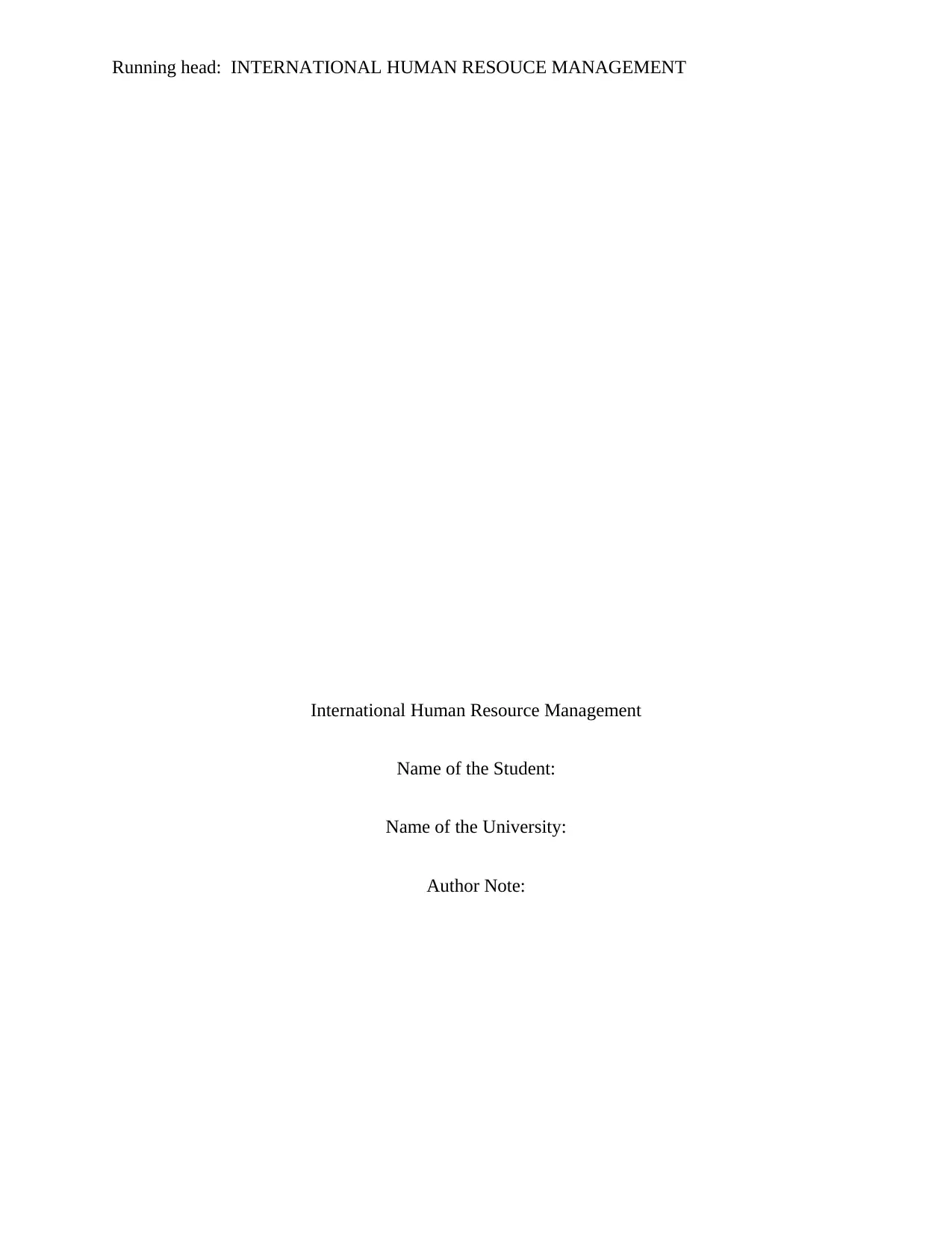
Running head: INTERNATIONAL HUMAN RESOUCE MANAGEMENT
International Human Resource Management
Name of the Student:
Name of the University:
Author Note:
International Human Resource Management
Name of the Student:
Name of the University:
Author Note:
Secure Best Marks with AI Grader
Need help grading? Try our AI Grader for instant feedback on your assignments.
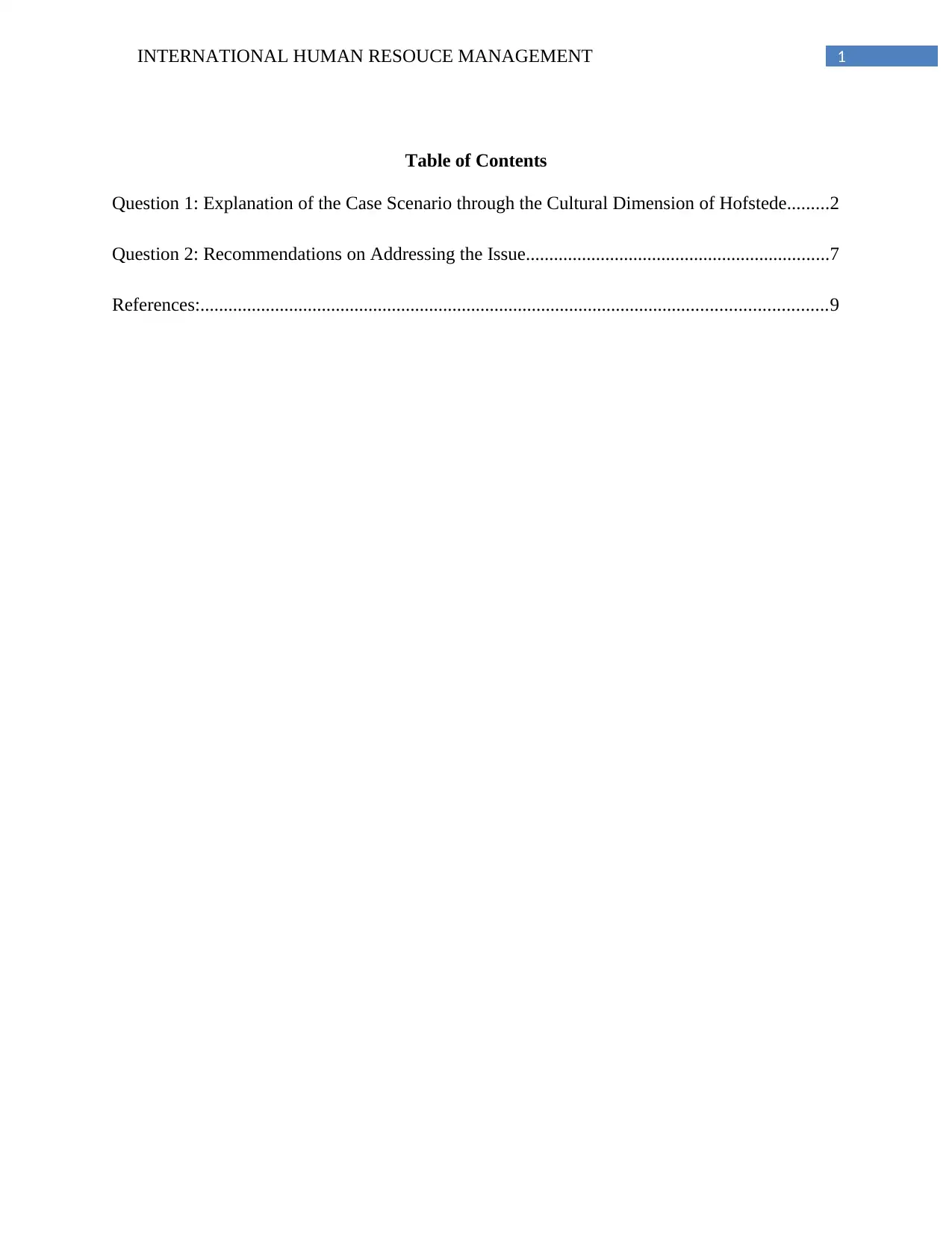
1INTERNATIONAL HUMAN RESOUCE MANAGEMENT
Table of Contents
Question 1: Explanation of the Case Scenario through the Cultural Dimension of Hofstede.........2
Question 2: Recommendations on Addressing the Issue.................................................................7
References:......................................................................................................................................9
Table of Contents
Question 1: Explanation of the Case Scenario through the Cultural Dimension of Hofstede.........2
Question 2: Recommendations on Addressing the Issue.................................................................7
References:......................................................................................................................................9
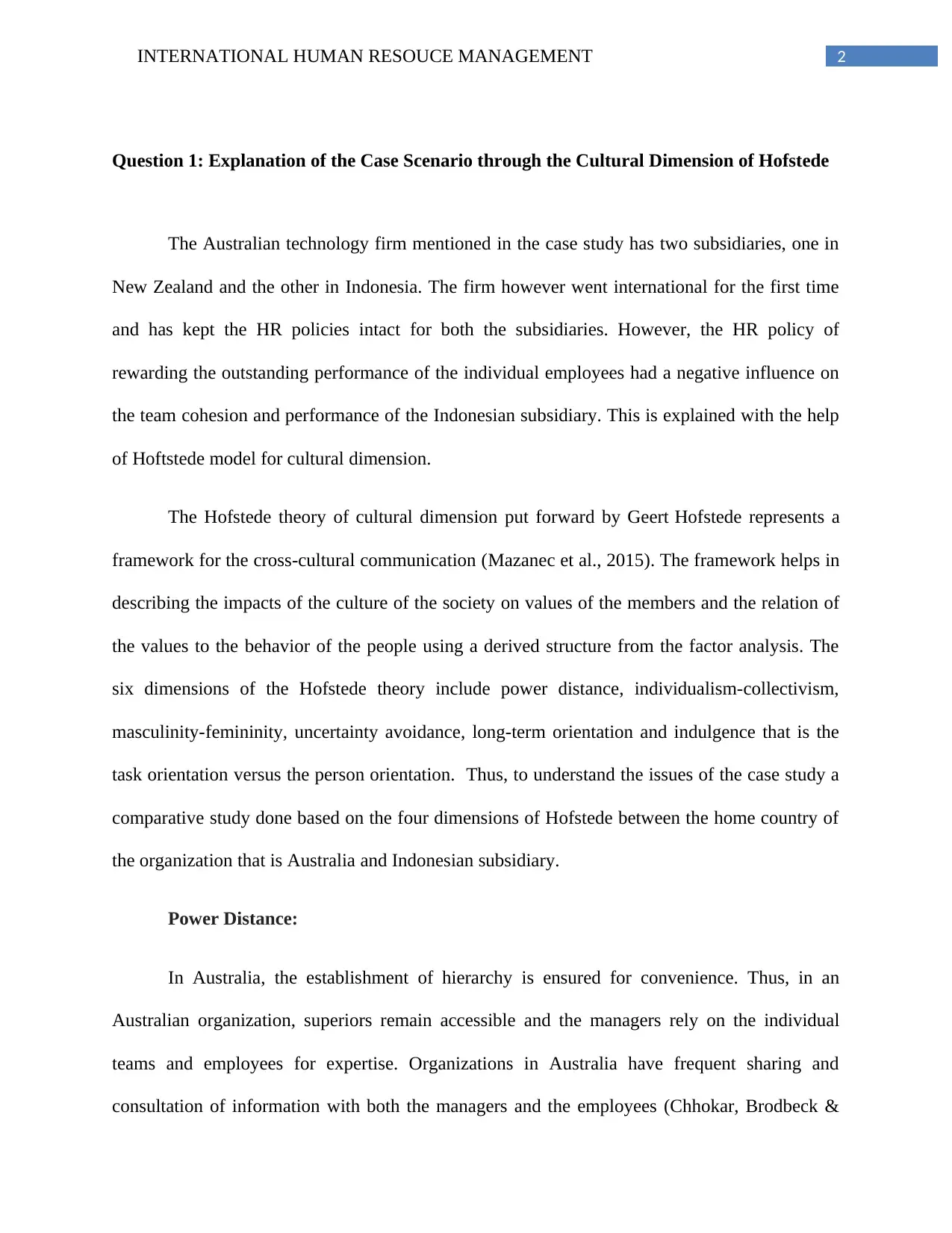
2INTERNATIONAL HUMAN RESOUCE MANAGEMENT
Question 1: Explanation of the Case Scenario through the Cultural Dimension of Hofstede
The Australian technology firm mentioned in the case study has two subsidiaries, one in
New Zealand and the other in Indonesia. The firm however went international for the first time
and has kept the HR policies intact for both the subsidiaries. However, the HR policy of
rewarding the outstanding performance of the individual employees had a negative influence on
the team cohesion and performance of the Indonesian subsidiary. This is explained with the help
of Hoftstede model for cultural dimension.
The Hofstede theory of cultural dimension put forward by Geert Hofstede represents a
framework for the cross-cultural communication (Mazanec et al., 2015). The framework helps in
describing the impacts of the culture of the society on values of the members and the relation of
the values to the behavior of the people using a derived structure from the factor analysis. The
six dimensions of the Hofstede theory include power distance, individualism-collectivism,
masculinity-femininity, uncertainty avoidance, long-term orientation and indulgence that is the
task orientation versus the person orientation. Thus, to understand the issues of the case study a
comparative study done based on the four dimensions of Hofstede between the home country of
the organization that is Australia and Indonesian subsidiary.
Power Distance:
In Australia, the establishment of hierarchy is ensured for convenience. Thus, in an
Australian organization, superiors remain accessible and the managers rely on the individual
teams and employees for expertise. Organizations in Australia have frequent sharing and
consultation of information with both the managers and the employees (Chhokar, Brodbeck &
Question 1: Explanation of the Case Scenario through the Cultural Dimension of Hofstede
The Australian technology firm mentioned in the case study has two subsidiaries, one in
New Zealand and the other in Indonesia. The firm however went international for the first time
and has kept the HR policies intact for both the subsidiaries. However, the HR policy of
rewarding the outstanding performance of the individual employees had a negative influence on
the team cohesion and performance of the Indonesian subsidiary. This is explained with the help
of Hoftstede model for cultural dimension.
The Hofstede theory of cultural dimension put forward by Geert Hofstede represents a
framework for the cross-cultural communication (Mazanec et al., 2015). The framework helps in
describing the impacts of the culture of the society on values of the members and the relation of
the values to the behavior of the people using a derived structure from the factor analysis. The
six dimensions of the Hofstede theory include power distance, individualism-collectivism,
masculinity-femininity, uncertainty avoidance, long-term orientation and indulgence that is the
task orientation versus the person orientation. Thus, to understand the issues of the case study a
comparative study done based on the four dimensions of Hofstede between the home country of
the organization that is Australia and Indonesian subsidiary.
Power Distance:
In Australia, the establishment of hierarchy is ensured for convenience. Thus, in an
Australian organization, superiors remain accessible and the managers rely on the individual
teams and employees for expertise. Organizations in Australia have frequent sharing and
consultation of information with both the managers and the employees (Chhokar, Brodbeck &
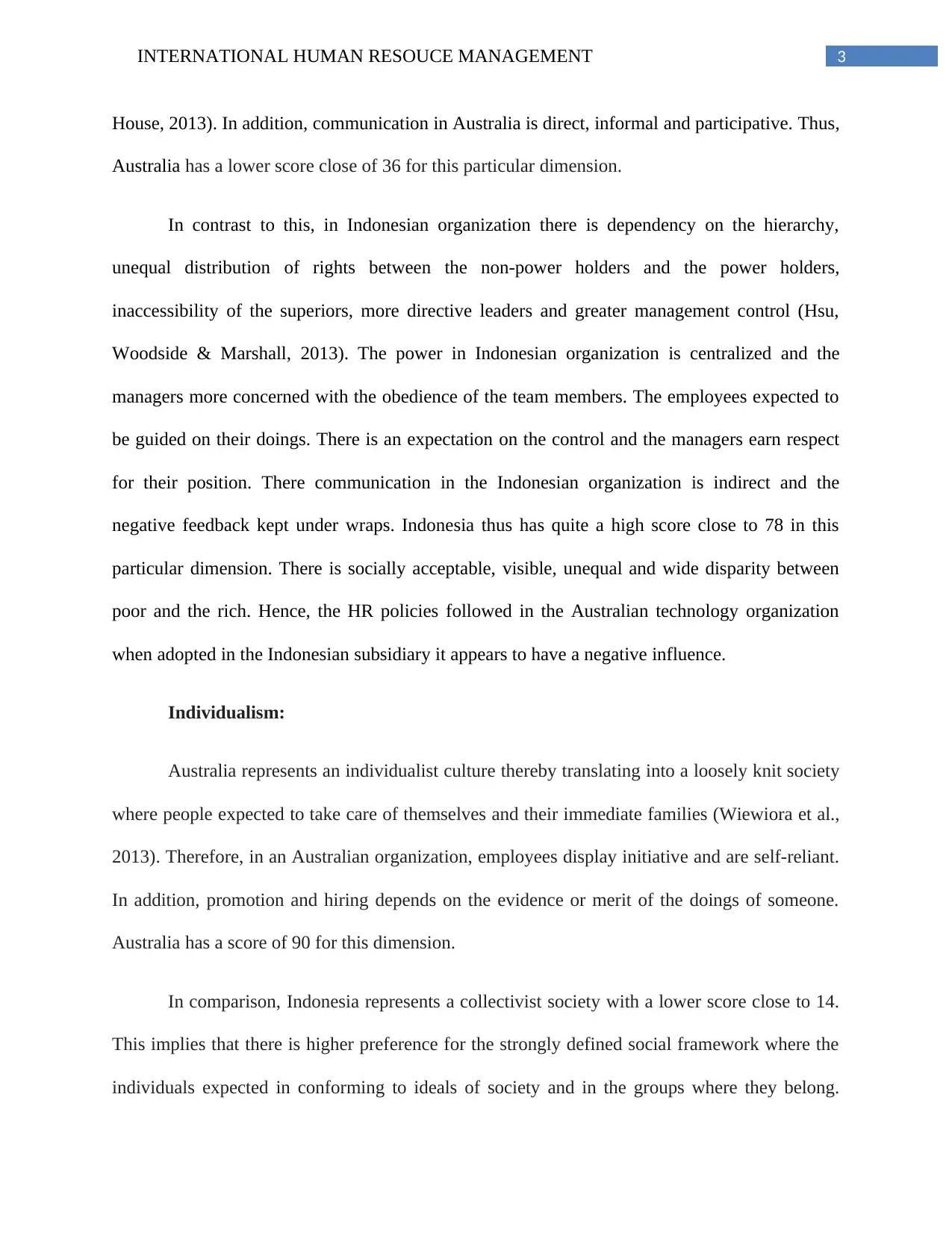
3INTERNATIONAL HUMAN RESOUCE MANAGEMENT
House, 2013). In addition, communication in Australia is direct, informal and participative. Thus,
Australia has a lower score close of 36 for this particular dimension.
In contrast to this, in Indonesian organization there is dependency on the hierarchy,
unequal distribution of rights between the non-power holders and the power holders,
inaccessibility of the superiors, more directive leaders and greater management control (Hsu,
Woodside & Marshall, 2013). The power in Indonesian organization is centralized and the
managers more concerned with the obedience of the team members. The employees expected to
be guided on their doings. There is an expectation on the control and the managers earn respect
for their position. There communication in the Indonesian organization is indirect and the
negative feedback kept under wraps. Indonesia thus has quite a high score close to 78 in this
particular dimension. There is socially acceptable, visible, unequal and wide disparity between
poor and the rich. Hence, the HR policies followed in the Australian technology organization
when adopted in the Indonesian subsidiary it appears to have a negative influence.
Individualism:
Australia represents an individualist culture thereby translating into a loosely knit society
where people expected to take care of themselves and their immediate families (Wiewiora et al.,
2013). Therefore, in an Australian organization, employees display initiative and are self-reliant.
In addition, promotion and hiring depends on the evidence or merit of the doings of someone.
Australia has a score of 90 for this dimension.
In comparison, Indonesia represents a collectivist society with a lower score close to 14.
This implies that there is higher preference for the strongly defined social framework where the
individuals expected in conforming to ideals of society and in the groups where they belong.
House, 2013). In addition, communication in Australia is direct, informal and participative. Thus,
Australia has a lower score close of 36 for this particular dimension.
In contrast to this, in Indonesian organization there is dependency on the hierarchy,
unequal distribution of rights between the non-power holders and the power holders,
inaccessibility of the superiors, more directive leaders and greater management control (Hsu,
Woodside & Marshall, 2013). The power in Indonesian organization is centralized and the
managers more concerned with the obedience of the team members. The employees expected to
be guided on their doings. There is an expectation on the control and the managers earn respect
for their position. There communication in the Indonesian organization is indirect and the
negative feedback kept under wraps. Indonesia thus has quite a high score close to 78 in this
particular dimension. There is socially acceptable, visible, unequal and wide disparity between
poor and the rich. Hence, the HR policies followed in the Australian technology organization
when adopted in the Indonesian subsidiary it appears to have a negative influence.
Individualism:
Australia represents an individualist culture thereby translating into a loosely knit society
where people expected to take care of themselves and their immediate families (Wiewiora et al.,
2013). Therefore, in an Australian organization, employees display initiative and are self-reliant.
In addition, promotion and hiring depends on the evidence or merit of the doings of someone.
Australia has a score of 90 for this dimension.
In comparison, Indonesia represents a collectivist society with a lower score close to 14.
This implies that there is higher preference for the strongly defined social framework where the
individuals expected in conforming to ideals of society and in the groups where they belong.
Secure Best Marks with AI Grader
Need help grading? Try our AI Grader for instant feedback on your assignments.
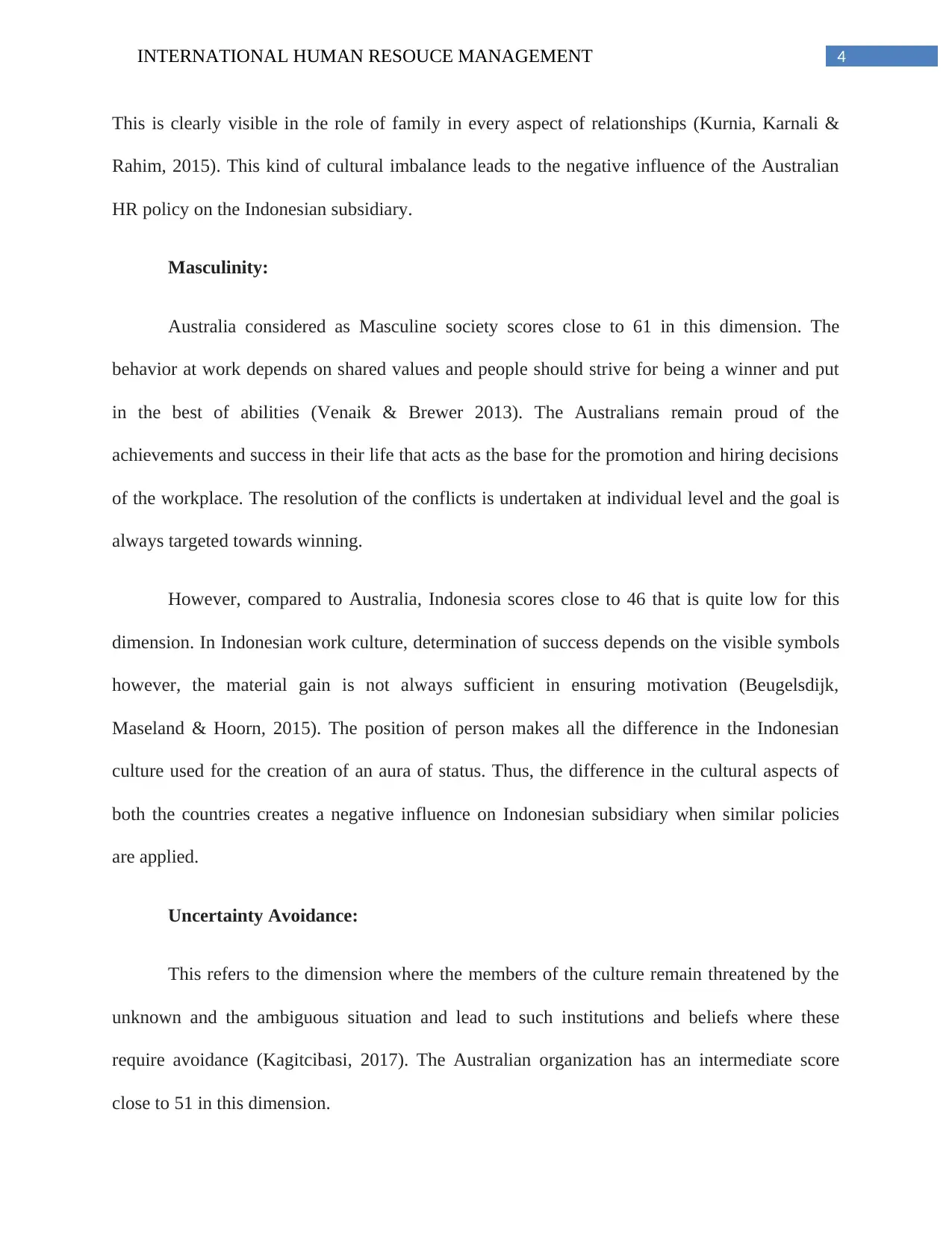
4INTERNATIONAL HUMAN RESOUCE MANAGEMENT
This is clearly visible in the role of family in every aspect of relationships (Kurnia, Karnali &
Rahim, 2015). This kind of cultural imbalance leads to the negative influence of the Australian
HR policy on the Indonesian subsidiary.
Masculinity:
Australia considered as Masculine society scores close to 61 in this dimension. The
behavior at work depends on shared values and people should strive for being a winner and put
in the best of abilities (Venaik & Brewer 2013). The Australians remain proud of the
achievements and success in their life that acts as the base for the promotion and hiring decisions
of the workplace. The resolution of the conflicts is undertaken at individual level and the goal is
always targeted towards winning.
However, compared to Australia, Indonesia scores close to 46 that is quite low for this
dimension. In Indonesian work culture, determination of success depends on the visible symbols
however, the material gain is not always sufficient in ensuring motivation (Beugelsdijk,
Maseland & Hoorn, 2015). The position of person makes all the difference in the Indonesian
culture used for the creation of an aura of status. Thus, the difference in the cultural aspects of
both the countries creates a negative influence on Indonesian subsidiary when similar policies
are applied.
Uncertainty Avoidance:
This refers to the dimension where the members of the culture remain threatened by the
unknown and the ambiguous situation and lead to such institutions and beliefs where these
require avoidance (Kagitcibasi, 2017). The Australian organization has an intermediate score
close to 51 in this dimension.
This is clearly visible in the role of family in every aspect of relationships (Kurnia, Karnali &
Rahim, 2015). This kind of cultural imbalance leads to the negative influence of the Australian
HR policy on the Indonesian subsidiary.
Masculinity:
Australia considered as Masculine society scores close to 61 in this dimension. The
behavior at work depends on shared values and people should strive for being a winner and put
in the best of abilities (Venaik & Brewer 2013). The Australians remain proud of the
achievements and success in their life that acts as the base for the promotion and hiring decisions
of the workplace. The resolution of the conflicts is undertaken at individual level and the goal is
always targeted towards winning.
However, compared to Australia, Indonesia scores close to 46 that is quite low for this
dimension. In Indonesian work culture, determination of success depends on the visible symbols
however, the material gain is not always sufficient in ensuring motivation (Beugelsdijk,
Maseland & Hoorn, 2015). The position of person makes all the difference in the Indonesian
culture used for the creation of an aura of status. Thus, the difference in the cultural aspects of
both the countries creates a negative influence on Indonesian subsidiary when similar policies
are applied.
Uncertainty Avoidance:
This refers to the dimension where the members of the culture remain threatened by the
unknown and the ambiguous situation and lead to such institutions and beliefs where these
require avoidance (Kagitcibasi, 2017). The Australian organization has an intermediate score
close to 51 in this dimension.
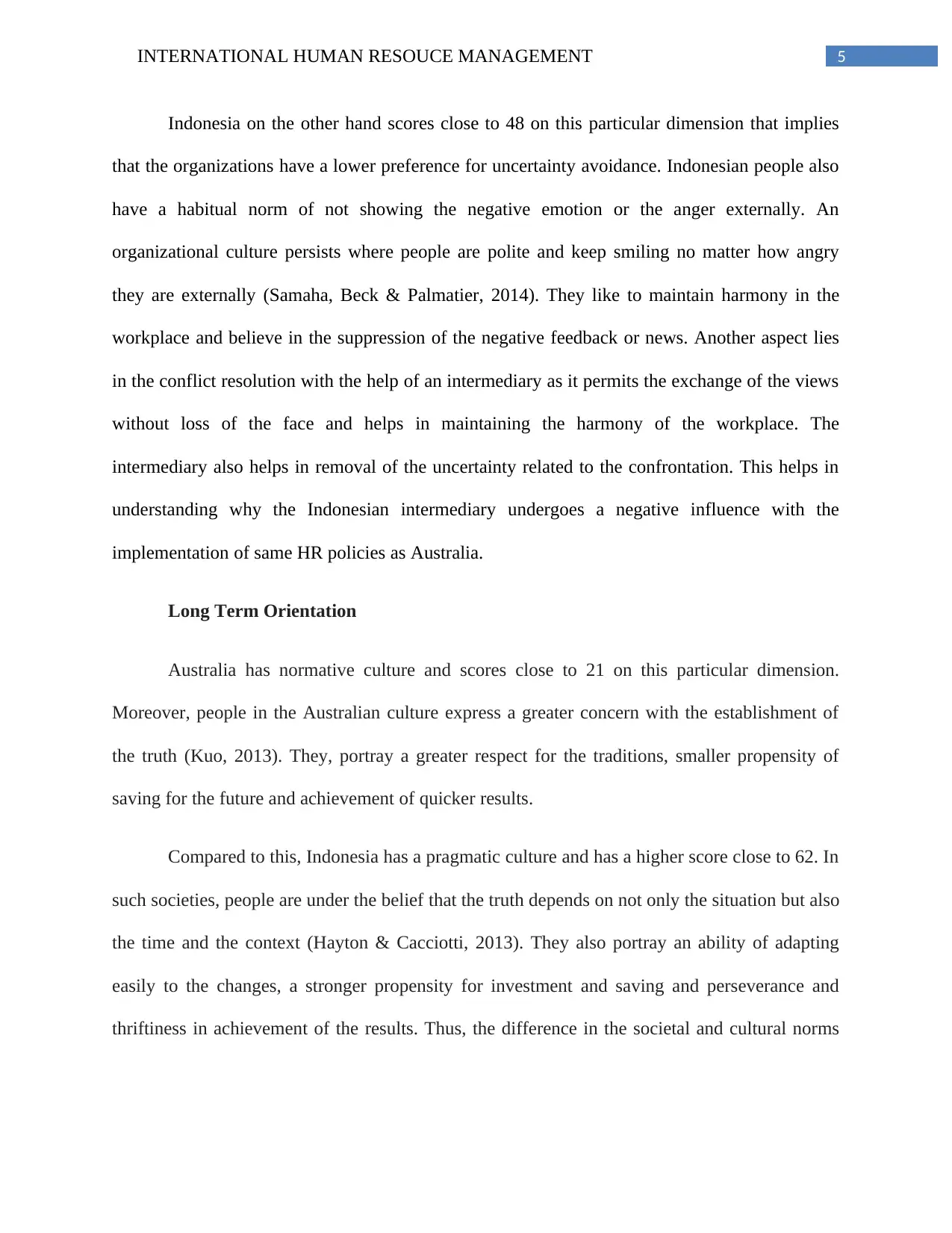
5INTERNATIONAL HUMAN RESOUCE MANAGEMENT
Indonesia on the other hand scores close to 48 on this particular dimension that implies
that the organizations have a lower preference for uncertainty avoidance. Indonesian people also
have a habitual norm of not showing the negative emotion or the anger externally. An
organizational culture persists where people are polite and keep smiling no matter how angry
they are externally (Samaha, Beck & Palmatier, 2014). They like to maintain harmony in the
workplace and believe in the suppression of the negative feedback or news. Another aspect lies
in the conflict resolution with the help of an intermediary as it permits the exchange of the views
without loss of the face and helps in maintaining the harmony of the workplace. The
intermediary also helps in removal of the uncertainty related to the confrontation. This helps in
understanding why the Indonesian intermediary undergoes a negative influence with the
implementation of same HR policies as Australia.
Long Term Orientation
Australia has normative culture and scores close to 21 on this particular dimension.
Moreover, people in the Australian culture express a greater concern with the establishment of
the truth (Kuo, 2013). They, portray a greater respect for the traditions, smaller propensity of
saving for the future and achievement of quicker results.
Compared to this, Indonesia has a pragmatic culture and has a higher score close to 62. In
such societies, people are under the belief that the truth depends on not only the situation but also
the time and the context (Hayton & Cacciotti, 2013). They also portray an ability of adapting
easily to the changes, a stronger propensity for investment and saving and perseverance and
thriftiness in achievement of the results. Thus, the difference in the societal and cultural norms
Indonesia on the other hand scores close to 48 on this particular dimension that implies
that the organizations have a lower preference for uncertainty avoidance. Indonesian people also
have a habitual norm of not showing the negative emotion or the anger externally. An
organizational culture persists where people are polite and keep smiling no matter how angry
they are externally (Samaha, Beck & Palmatier, 2014). They like to maintain harmony in the
workplace and believe in the suppression of the negative feedback or news. Another aspect lies
in the conflict resolution with the help of an intermediary as it permits the exchange of the views
without loss of the face and helps in maintaining the harmony of the workplace. The
intermediary also helps in removal of the uncertainty related to the confrontation. This helps in
understanding why the Indonesian intermediary undergoes a negative influence with the
implementation of same HR policies as Australia.
Long Term Orientation
Australia has normative culture and scores close to 21 on this particular dimension.
Moreover, people in the Australian culture express a greater concern with the establishment of
the truth (Kuo, 2013). They, portray a greater respect for the traditions, smaller propensity of
saving for the future and achievement of quicker results.
Compared to this, Indonesia has a pragmatic culture and has a higher score close to 62. In
such societies, people are under the belief that the truth depends on not only the situation but also
the time and the context (Hayton & Cacciotti, 2013). They also portray an ability of adapting
easily to the changes, a stronger propensity for investment and saving and perseverance and
thriftiness in achievement of the results. Thus, the difference in the societal and cultural norms
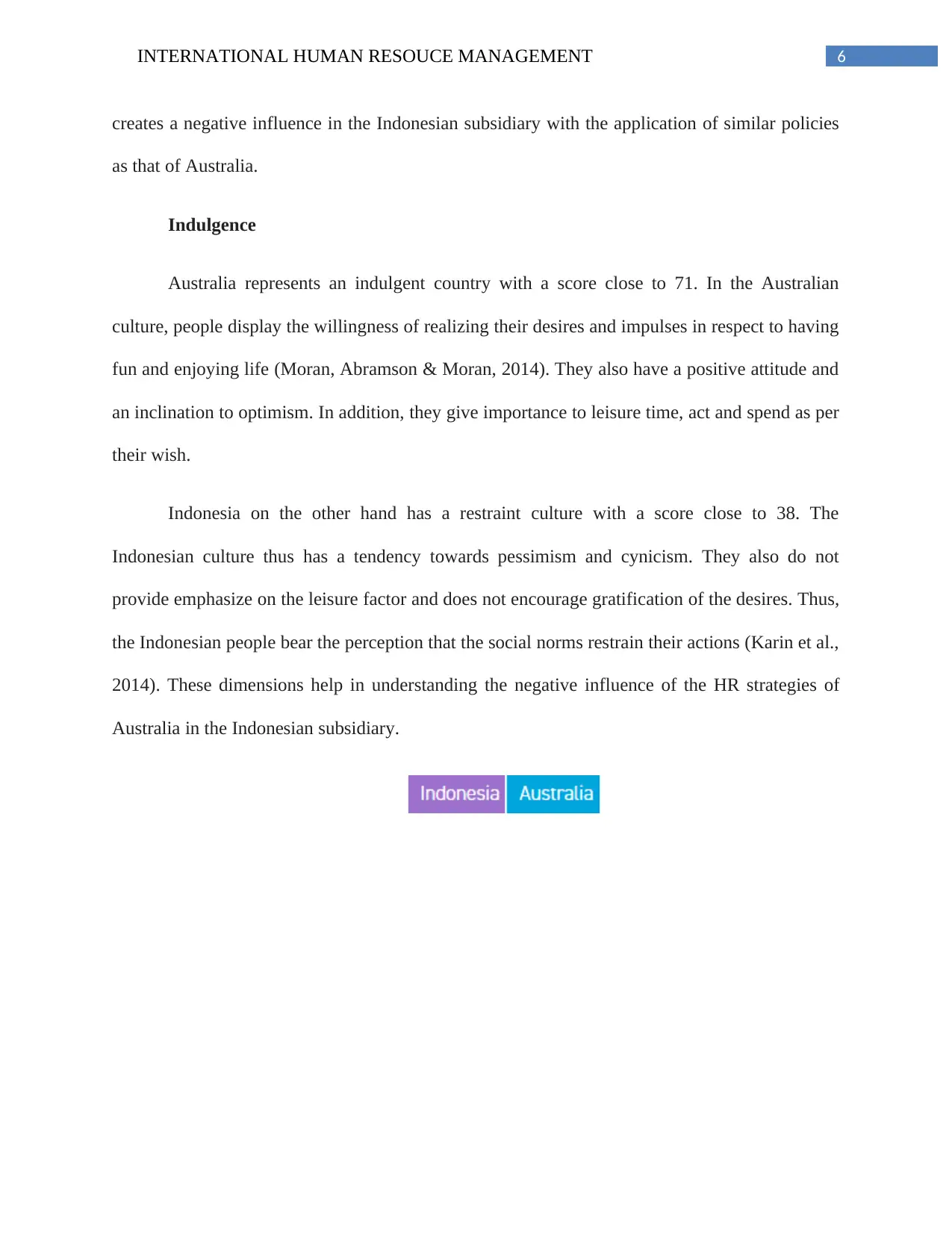
6INTERNATIONAL HUMAN RESOUCE MANAGEMENT
creates a negative influence in the Indonesian subsidiary with the application of similar policies
as that of Australia.
Indulgence
Australia represents an indulgent country with a score close to 71. In the Australian
culture, people display the willingness of realizing their desires and impulses in respect to having
fun and enjoying life (Moran, Abramson & Moran, 2014). They also have a positive attitude and
an inclination to optimism. In addition, they give importance to leisure time, act and spend as per
their wish.
Indonesia on the other hand has a restraint culture with a score close to 38. The
Indonesian culture thus has a tendency towards pessimism and cynicism. They also do not
provide emphasize on the leisure factor and does not encourage gratification of the desires. Thus,
the Indonesian people bear the perception that the social norms restrain their actions (Karin et al.,
2014). These dimensions help in understanding the negative influence of the HR strategies of
Australia in the Indonesian subsidiary.
creates a negative influence in the Indonesian subsidiary with the application of similar policies
as that of Australia.
Indulgence
Australia represents an indulgent country with a score close to 71. In the Australian
culture, people display the willingness of realizing their desires and impulses in respect to having
fun and enjoying life (Moran, Abramson & Moran, 2014). They also have a positive attitude and
an inclination to optimism. In addition, they give importance to leisure time, act and spend as per
their wish.
Indonesia on the other hand has a restraint culture with a score close to 38. The
Indonesian culture thus has a tendency towards pessimism and cynicism. They also do not
provide emphasize on the leisure factor and does not encourage gratification of the desires. Thus,
the Indonesian people bear the perception that the social norms restrain their actions (Karin et al.,
2014). These dimensions help in understanding the negative influence of the HR strategies of
Australia in the Indonesian subsidiary.
Paraphrase This Document
Need a fresh take? Get an instant paraphrase of this document with our AI Paraphraser
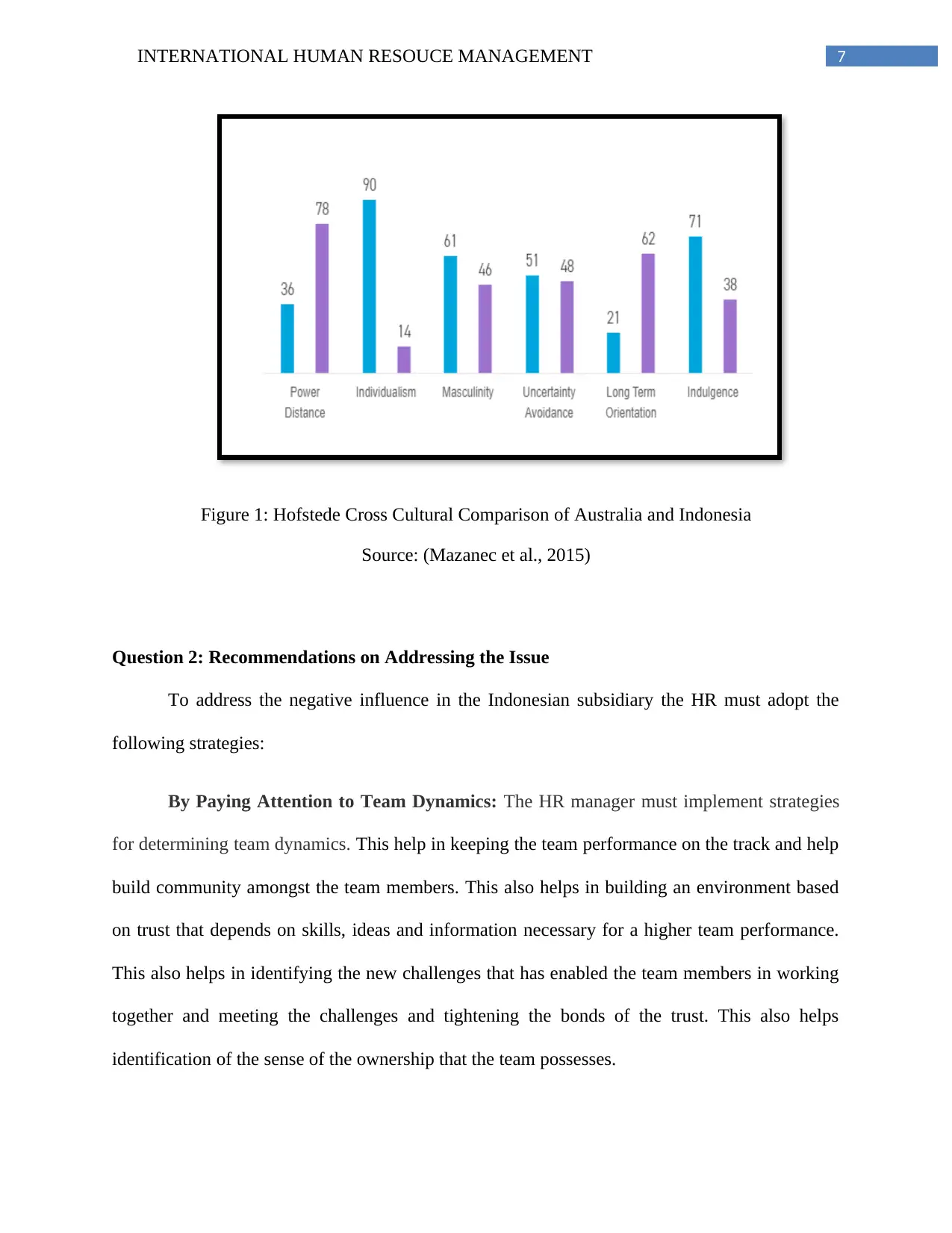
7INTERNATIONAL HUMAN RESOUCE MANAGEMENT
Figure 1: Hofstede Cross Cultural Comparison of Australia and Indonesia
Source: (Mazanec et al., 2015)
Question 2: Recommendations on Addressing the Issue
To address the negative influence in the Indonesian subsidiary the HR must adopt the
following strategies:
By Paying Attention to Team Dynamics: The HR manager must implement strategies
for determining team dynamics. This help in keeping the team performance on the track and help
build community amongst the team members. This also helps in building an environment based
on trust that depends on skills, ideas and information necessary for a higher team performance.
This also helps in identifying the new challenges that has enabled the team members in working
together and meeting the challenges and tightening the bonds of the trust. This also helps
identification of the sense of the ownership that the team possesses.
Figure 1: Hofstede Cross Cultural Comparison of Australia and Indonesia
Source: (Mazanec et al., 2015)
Question 2: Recommendations on Addressing the Issue
To address the negative influence in the Indonesian subsidiary the HR must adopt the
following strategies:
By Paying Attention to Team Dynamics: The HR manager must implement strategies
for determining team dynamics. This help in keeping the team performance on the track and help
build community amongst the team members. This also helps in building an environment based
on trust that depends on skills, ideas and information necessary for a higher team performance.
This also helps in identifying the new challenges that has enabled the team members in working
together and meeting the challenges and tightening the bonds of the trust. This also helps
identification of the sense of the ownership that the team possesses.

8INTERNATIONAL HUMAN RESOUCE MANAGEMENT
Undertaking Recruitment with Care: The HR manager must ensure recruitment of the
team members from either outside or from existing pool. During the appointment of team
members one must consider the ability of the people to work in teams. For instance, if candidates
possess higher levels of the technical skills but lack the ability of working collaboratively then
the person is not ideal for working in team. Even the higher levels of arguments and conflicts
will lead to difficulty in achieving the team cohesion.
Observing Team Goal and Targets: The HR manager should keep an eye on team
members whether they are working towards same targets and goals. If the team does not have a
shared vision, they are likely to develop a competition and a conflict. Moreover, a shared vision
helps in understanding the purpose of the team.
By Valuing Every Employee: The HR manager must consider the contribution of every
member while determining performance management of the employees. This is because some
people have technical expertise while others might have financial or administrative skills. Thus,
each member must have a feeling that his or her contribution is valued.
By Empowering the Team Members: The HR manager must implement policies in
empowering the team members. Teams must be empowered in making a decision that also helps
in increasing the team cohesion. The team members should be able in pulling together and
working collaboratively for achieving the outcome agreed. Empowerment works ideally in a
situation when everyone is clear about decision that needs implementation and further
authorization.
Undertaking Recruitment with Care: The HR manager must ensure recruitment of the
team members from either outside or from existing pool. During the appointment of team
members one must consider the ability of the people to work in teams. For instance, if candidates
possess higher levels of the technical skills but lack the ability of working collaboratively then
the person is not ideal for working in team. Even the higher levels of arguments and conflicts
will lead to difficulty in achieving the team cohesion.
Observing Team Goal and Targets: The HR manager should keep an eye on team
members whether they are working towards same targets and goals. If the team does not have a
shared vision, they are likely to develop a competition and a conflict. Moreover, a shared vision
helps in understanding the purpose of the team.
By Valuing Every Employee: The HR manager must consider the contribution of every
member while determining performance management of the employees. This is because some
people have technical expertise while others might have financial or administrative skills. Thus,
each member must have a feeling that his or her contribution is valued.
By Empowering the Team Members: The HR manager must implement policies in
empowering the team members. Teams must be empowered in making a decision that also helps
in increasing the team cohesion. The team members should be able in pulling together and
working collaboratively for achieving the outcome agreed. Empowerment works ideally in a
situation when everyone is clear about decision that needs implementation and further
authorization.
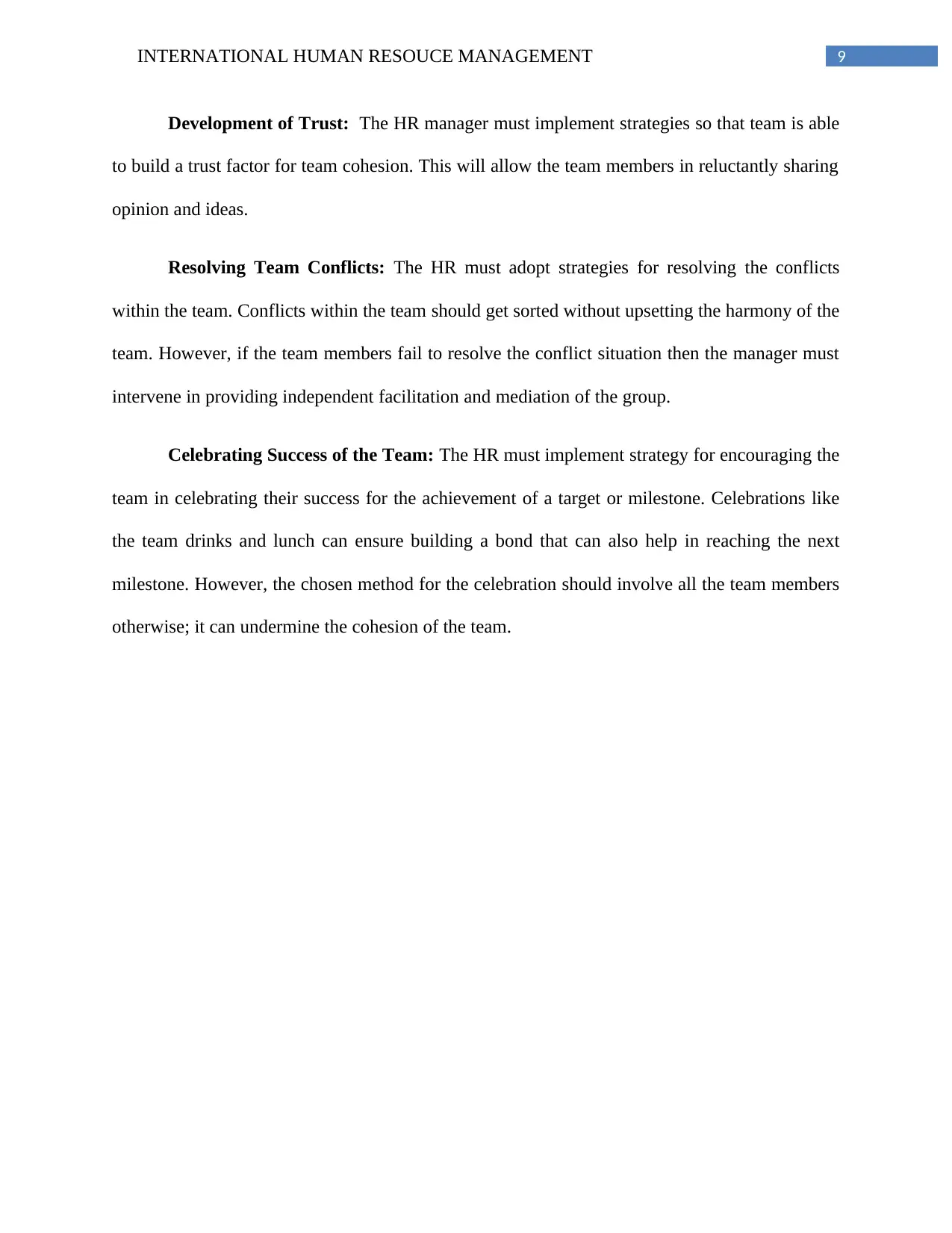
9INTERNATIONAL HUMAN RESOUCE MANAGEMENT
Development of Trust: The HR manager must implement strategies so that team is able
to build a trust factor for team cohesion. This will allow the team members in reluctantly sharing
opinion and ideas.
Resolving Team Conflicts: The HR must adopt strategies for resolving the conflicts
within the team. Conflicts within the team should get sorted without upsetting the harmony of the
team. However, if the team members fail to resolve the conflict situation then the manager must
intervene in providing independent facilitation and mediation of the group.
Celebrating Success of the Team: The HR must implement strategy for encouraging the
team in celebrating their success for the achievement of a target or milestone. Celebrations like
the team drinks and lunch can ensure building a bond that can also help in reaching the next
milestone. However, the chosen method for the celebration should involve all the team members
otherwise; it can undermine the cohesion of the team.
Development of Trust: The HR manager must implement strategies so that team is able
to build a trust factor for team cohesion. This will allow the team members in reluctantly sharing
opinion and ideas.
Resolving Team Conflicts: The HR must adopt strategies for resolving the conflicts
within the team. Conflicts within the team should get sorted without upsetting the harmony of the
team. However, if the team members fail to resolve the conflict situation then the manager must
intervene in providing independent facilitation and mediation of the group.
Celebrating Success of the Team: The HR must implement strategy for encouraging the
team in celebrating their success for the achievement of a target or milestone. Celebrations like
the team drinks and lunch can ensure building a bond that can also help in reaching the next
milestone. However, the chosen method for the celebration should involve all the team members
otherwise; it can undermine the cohesion of the team.
Secure Best Marks with AI Grader
Need help grading? Try our AI Grader for instant feedback on your assignments.
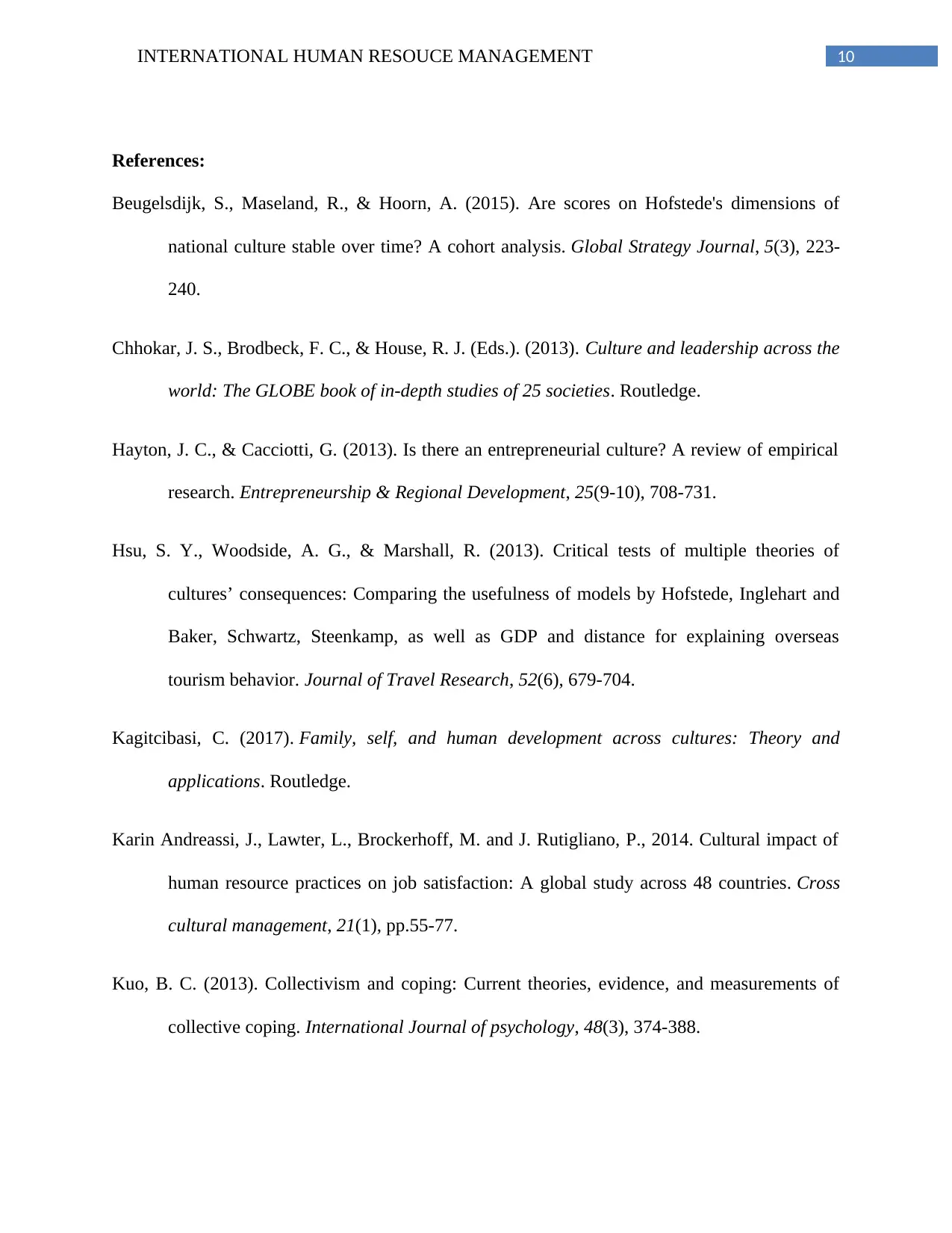
10INTERNATIONAL HUMAN RESOUCE MANAGEMENT
References:
Beugelsdijk, S., Maseland, R., & Hoorn, A. (2015). Are scores on Hofstede's dimensions of
national culture stable over time? A cohort analysis. Global Strategy Journal, 5(3), 223-
240.
Chhokar, J. S., Brodbeck, F. C., & House, R. J. (Eds.). (2013). Culture and leadership across the
world: The GLOBE book of in-depth studies of 25 societies. Routledge.
Hayton, J. C., & Cacciotti, G. (2013). Is there an entrepreneurial culture? A review of empirical
research. Entrepreneurship & Regional Development, 25(9-10), 708-731.
Hsu, S. Y., Woodside, A. G., & Marshall, R. (2013). Critical tests of multiple theories of
cultures’ consequences: Comparing the usefulness of models by Hofstede, Inglehart and
Baker, Schwartz, Steenkamp, as well as GDP and distance for explaining overseas
tourism behavior. Journal of Travel Research, 52(6), 679-704.
Kagitcibasi, C. (2017). Family, self, and human development across cultures: Theory and
applications. Routledge.
Karin Andreassi, J., Lawter, L., Brockerhoff, M. and J. Rutigliano, P., 2014. Cultural impact of
human resource practices on job satisfaction: A global study across 48 countries. Cross
cultural management, 21(1), pp.55-77.
Kuo, B. C. (2013). Collectivism and coping: Current theories, evidence, and measurements of
collective coping. International Journal of psychology, 48(3), 374-388.
References:
Beugelsdijk, S., Maseland, R., & Hoorn, A. (2015). Are scores on Hofstede's dimensions of
national culture stable over time? A cohort analysis. Global Strategy Journal, 5(3), 223-
240.
Chhokar, J. S., Brodbeck, F. C., & House, R. J. (Eds.). (2013). Culture and leadership across the
world: The GLOBE book of in-depth studies of 25 societies. Routledge.
Hayton, J. C., & Cacciotti, G. (2013). Is there an entrepreneurial culture? A review of empirical
research. Entrepreneurship & Regional Development, 25(9-10), 708-731.
Hsu, S. Y., Woodside, A. G., & Marshall, R. (2013). Critical tests of multiple theories of
cultures’ consequences: Comparing the usefulness of models by Hofstede, Inglehart and
Baker, Schwartz, Steenkamp, as well as GDP and distance for explaining overseas
tourism behavior. Journal of Travel Research, 52(6), 679-704.
Kagitcibasi, C. (2017). Family, self, and human development across cultures: Theory and
applications. Routledge.
Karin Andreassi, J., Lawter, L., Brockerhoff, M. and J. Rutigliano, P., 2014. Cultural impact of
human resource practices on job satisfaction: A global study across 48 countries. Cross
cultural management, 21(1), pp.55-77.
Kuo, B. C. (2013). Collectivism and coping: Current theories, evidence, and measurements of
collective coping. International Journal of psychology, 48(3), 374-388.
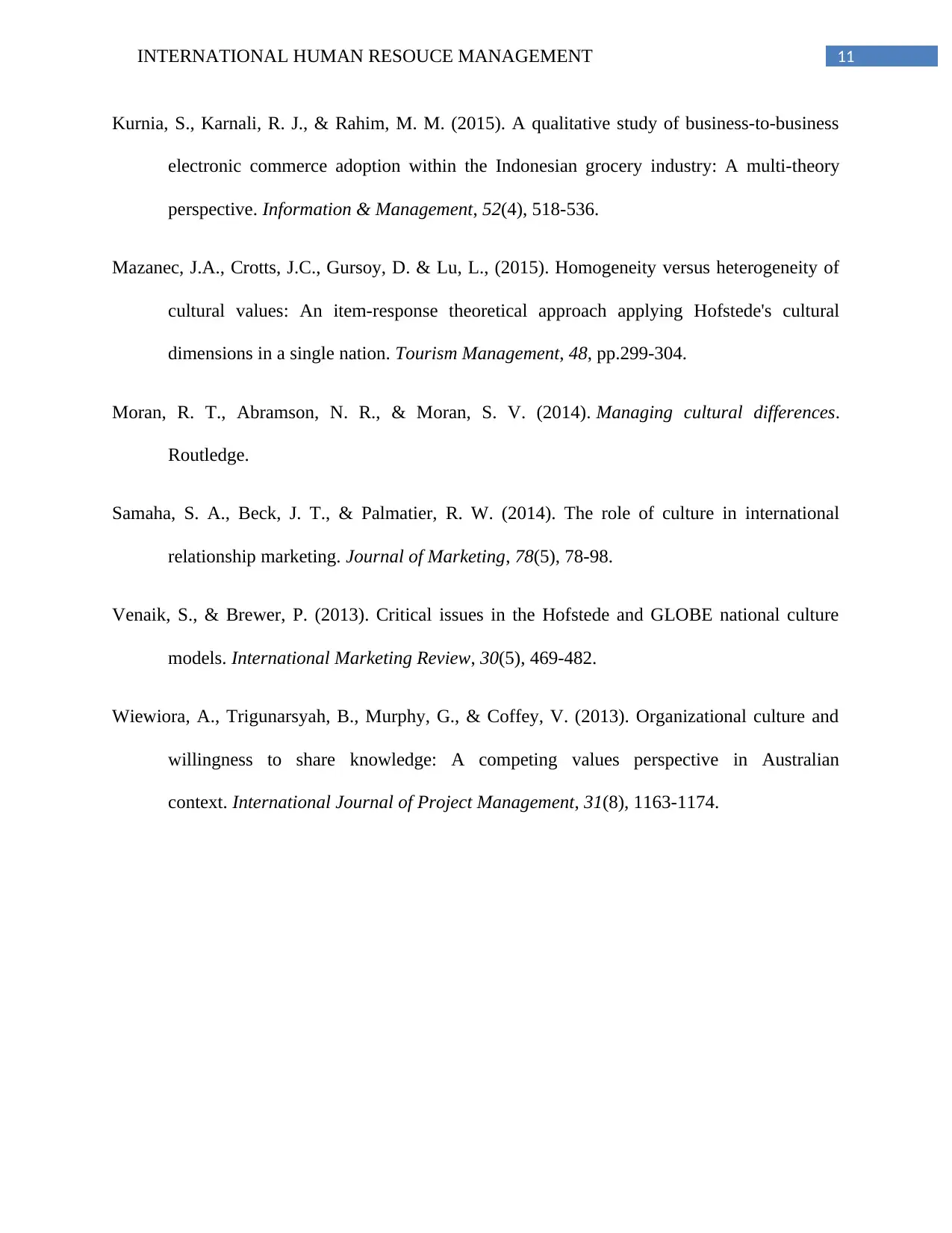
11INTERNATIONAL HUMAN RESOUCE MANAGEMENT
Kurnia, S., Karnali, R. J., & Rahim, M. M. (2015). A qualitative study of business-to-business
electronic commerce adoption within the Indonesian grocery industry: A multi-theory
perspective. Information & Management, 52(4), 518-536.
Mazanec, J.A., Crotts, J.C., Gursoy, D. & Lu, L., (2015). Homogeneity versus heterogeneity of
cultural values: An item-response theoretical approach applying Hofstede's cultural
dimensions in a single nation. Tourism Management, 48, pp.299-304.
Moran, R. T., Abramson, N. R., & Moran, S. V. (2014). Managing cultural differences.
Routledge.
Samaha, S. A., Beck, J. T., & Palmatier, R. W. (2014). The role of culture in international
relationship marketing. Journal of Marketing, 78(5), 78-98.
Venaik, S., & Brewer, P. (2013). Critical issues in the Hofstede and GLOBE national culture
models. International Marketing Review, 30(5), 469-482.
Wiewiora, A., Trigunarsyah, B., Murphy, G., & Coffey, V. (2013). Organizational culture and
willingness to share knowledge: A competing values perspective in Australian
context. International Journal of Project Management, 31(8), 1163-1174.
Kurnia, S., Karnali, R. J., & Rahim, M. M. (2015). A qualitative study of business-to-business
electronic commerce adoption within the Indonesian grocery industry: A multi-theory
perspective. Information & Management, 52(4), 518-536.
Mazanec, J.A., Crotts, J.C., Gursoy, D. & Lu, L., (2015). Homogeneity versus heterogeneity of
cultural values: An item-response theoretical approach applying Hofstede's cultural
dimensions in a single nation. Tourism Management, 48, pp.299-304.
Moran, R. T., Abramson, N. R., & Moran, S. V. (2014). Managing cultural differences.
Routledge.
Samaha, S. A., Beck, J. T., & Palmatier, R. W. (2014). The role of culture in international
relationship marketing. Journal of Marketing, 78(5), 78-98.
Venaik, S., & Brewer, P. (2013). Critical issues in the Hofstede and GLOBE national culture
models. International Marketing Review, 30(5), 469-482.
Wiewiora, A., Trigunarsyah, B., Murphy, G., & Coffey, V. (2013). Organizational culture and
willingness to share knowledge: A competing values perspective in Australian
context. International Journal of Project Management, 31(8), 1163-1174.
1 out of 12
Related Documents
Your All-in-One AI-Powered Toolkit for Academic Success.
+13062052269
info@desklib.com
Available 24*7 on WhatsApp / Email
![[object Object]](/_next/static/media/star-bottom.7253800d.svg)
Unlock your academic potential
© 2024 | Zucol Services PVT LTD | All rights reserved.




